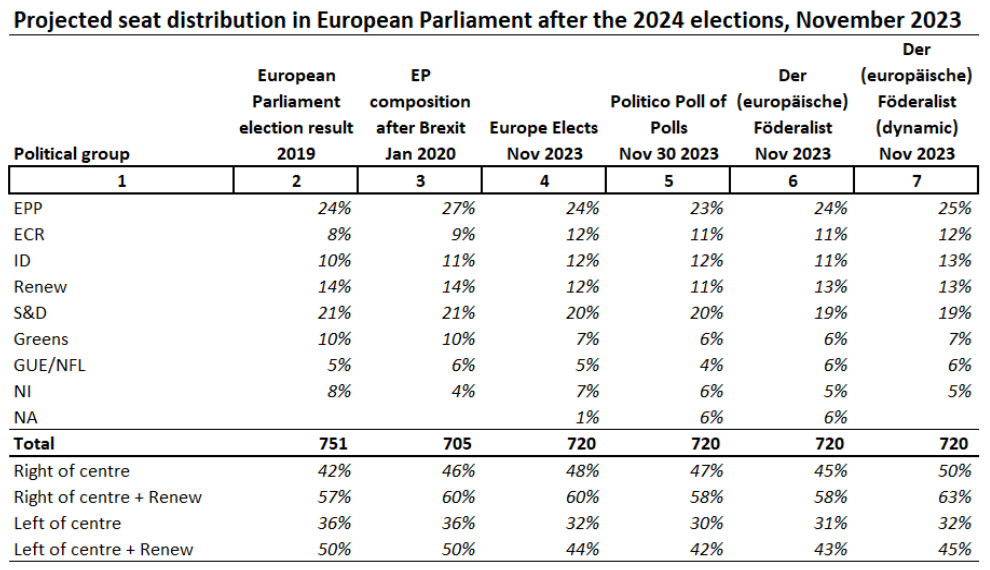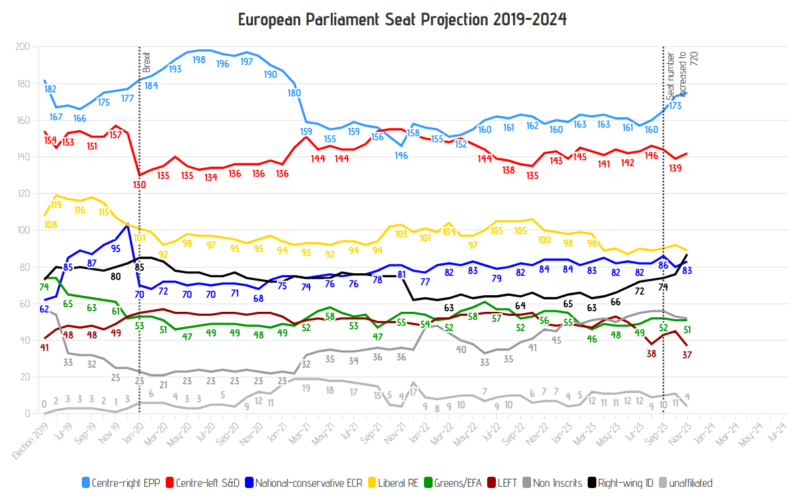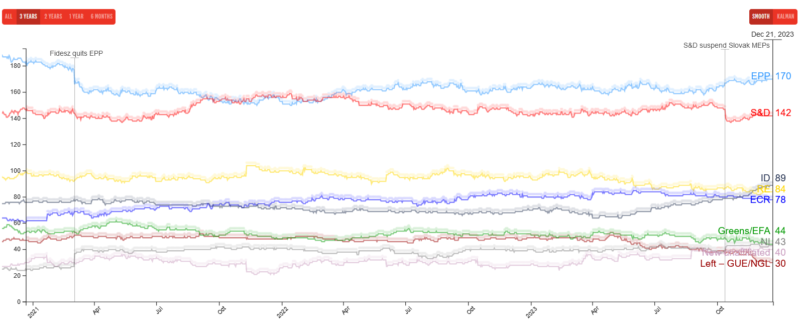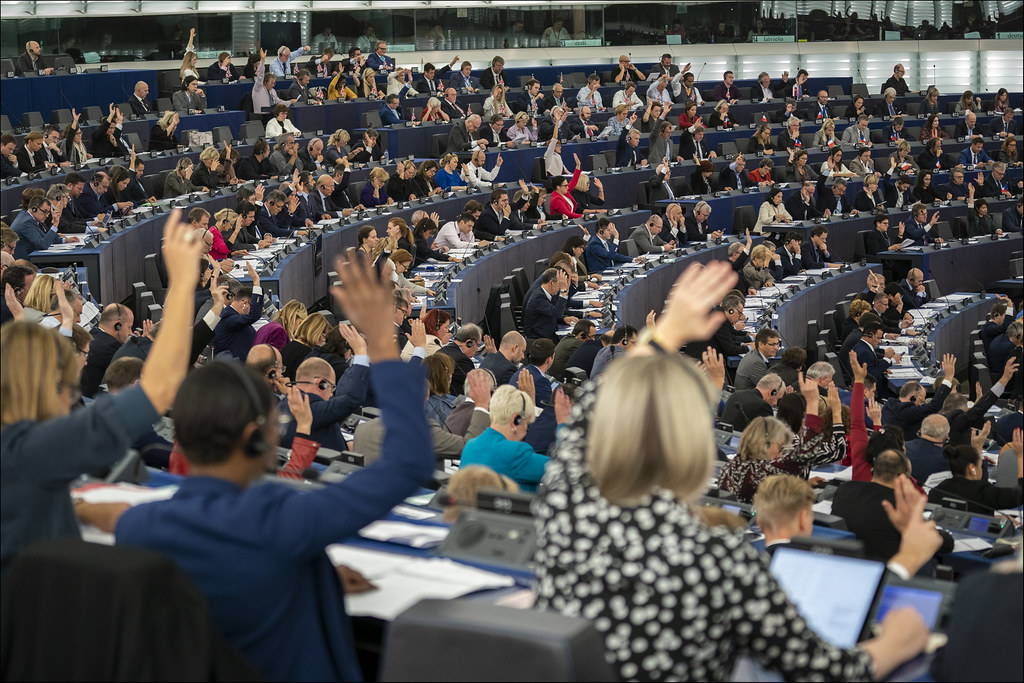Latest polling results from the three institutions that provide regular updates on seat projections for the European Parliament elections in June 2024 now point for the first time to the possibility that the three right-of-centre political groups – the EPP, ID and ECR – may have a majority of seats on their own in the next Parliament.
My previous synthesis of the seat projections in May 2023 (see my blog post here) showed that the left-of-centre groups – S&D, Greens and the Left – together with Renew were still slightly ahead of the right-of-centre groups though they would have required support from the independent MEPs – the so-called Non-Inscrits – to create an overall majority. This is no longer the case.
In the following table, I present the seat projections by the three institutions – Europe Elects, Politico Poll of Polls, and Der (europäische) Föderalist – as a percentage of the overall number of seats (note, this is not a projection of the share of total votes received by the national political parties affiliated with these political groups). The percentage shares are more meaningful because the total number of seats in the Parliament changes over time, and they are also easier to interpret. Note that the methodology used by each organization to project the number of seats differs as do the national polls they use on which to base their projections.
Following the last elections to the European Parliament in 2019, the first change in the number of seats took place in January 2020 following the UK’s departure from the Union. The number of seats dropped from 751 to 705. For the Parliament to be elected in 2024, seat numbers had to be adjusted again to take account of population changes in different countries, in line with principles set out in the Treaties (i.e. a maximum of 750 MEPs plus the President, no less than 6 and no more than 96 seats for any EU country, and the “degressive proportionality” principle), and based on the most recent population figures). While the Parliament’s proposal in June 2023 included a reserve of 28 seats for members elected in a future Union-wide constituency, this idea was not accepted by the European Council. Its proposal to add an additional 15 seats to bring the number of seats to 720 was approved by the Parliament in September 2023.

Notes: Right of centre consists of EPP, ECR and ID. Left of centre consists of S&D, Greens, and GUE/NFL (the Left). NI are Non-Inscrits, MEPs who remain independent of any political group. NA are MEPs elected for national political parties that have not yet declared which political group they will seek to join. Europe Elects attempts to align new parties with existing political groups often by communicating with them, hence its figure for NA MEPs is lower than for the other two organisations. Der (europäische) Föderalist also prepares a dynamic projection (Column 7) in which it makes its own assessment of the political groups which MEPs from new parties will join.
There are seven political groups in the European Parliament, plus a group of independent MEPs (Non-Inscrits) who are not affiliated with any political group. The seat projections by the three institutions are rather similar, although Der (europäische) Föderalist appears to be more generous in its outcomes for Renew and the Left. We should also keep in mind that the Europe Elects and Der (europäische) Föderalist (dynamic) projections apportion the NA (not affiliated) grouping to the political group they are most likely to join. This means that their projected seat percentages for the individual groups are generally slightly higher than the Politico and unadjusted Der (europäische) Föderalist projections. While there is some uncertainty about which political group new parties elected to the Parliament will join, and whether individual MEPs when elected will join the political group to which their political party is aligned, these adjusted results are likely to give a more illuminating breakdown of the relative strength of the political groups.
The implications of these seat projections for the right/left balance of power in the Parliament to be elected next June is shown in the last four rows of the table. The most relevant comparison is with the percentage distribution of seats in January 2020 after Brexit. This gave a relative boost to the EPP (and to a smaller extent the two other right-wing parties) because of the disappearance of the pro-Brexit UKIP party. This party had been included among the NIs as they had not affiliated with any political group while the S&D lost the seats of former UK Labour Party MEPs.
The trends since January 2020 are clear. While the left-of-centre group, if Renew is added, just commanded a majority without counting the NIs in 2020, that 50% share has now fallen to 44-45% in the adjusted results. Correspondingly, the share of the three right-of-centre parties has increased from 46% in 2020 to 48-50% in the adjusted seat projections. There is also a shift in the balance of power within the right-of-centre group. The EPP has lost seat share at the expense of both the ECR but particularly ID. A significant explanation for this reduced EPP seat share is the exit of Hungarian Fidesz from the EPP in March 2021 after the latter changed its rules to permit the exclusion of a member or members of the group. The suspension of three Slovakian MEPs belonging to the SMER and HLAS parties from the S&D group in October 2023 is treated as an expulsion by Der (europäische) Föderalist and they are moved to the NI group; it is not clear how these parties are treated in the other two projections.
Both Europe Elects and Politico show charts of how their seat projections change over time which throw further light on these trends (Der (europäische) Föderalist also includes a time trend but in the form of a table). The Europe Elects chart shows its monthly projections since the last election in 2019 (note that the seat numbers have been normalized to total 720 throughout the period). If we focus on the most recent months, of particular interest is the rapid growth in support for national parties associated with the EPP (whose projected seat numbers increased from 157 in July 2023 to 175 in November, as well as for ID (with a growth in projected seat numbers from 72 in July 2023 to 87 in November). There has also been a sharp fall in the projected seat numbers for the Left (from 45 in July 2023 to 37 in November) plus smaller changes for the other groups. On this reading, the two right-of-centre political groups have momentum at the present time.

Source: Europe Elects
These trends are largely confirmed by the more recent data from the Politico Poll of Polls which at the time of writing goes to 21 December 2023. These data are not totally comparable with Europe Elects because Politico does not attempt to match its 40 Non-Attached (NA) MEPs to the political groups they are likely to join. Still, the momentum behind the EPP and ID and the loss of support for the Left in recent months are clear.

Source: Politico Poll of Polls
Conclusions
There are still just over five months before elections to the European Parliament will be held in June 2024. The data examined here are based on polling data for national political parties which are then used to provide seat projections for the political groups in the Parliament with which these national parties are associated.
There can be many reasons why the distribution of votes between national political parties for national elections may well differ from the outcome in European Parliament elections. One major factor I highlighted in my previous blog post is the importance of turnout. European Parliament elections usually attract a much lower turnout than national elections. But the 2019 election bucked the trend of falling participation rates and there was a significant increase in voter participation in that year. This appears to have been linked to the greater mobilization among younger voters who were particularly exercised by climate and other environmental issues and whose support resulted in gains for the Greens and Renew who were perceived to be stronger on these issues. The more sombre context in which the 2024 elections will take place (in the wake of the covid and cost of living crises, in the shadow of war on the European continent and in the Middle East, and with growing irregular immigration pressures, as per the latest Eurobarometer survey) may mean that many of these younger voters stay at home.
Even with these caveats, the latest polling data now suggest for the first time that the three right-of-centre parties between them could end up controlling a majority of seats. This is not to diminish the significant differences between these parties, particularly between the pro-Europe EPP and the more eurosceptic ECR and particularly ID. The eurosceptic parties would still control just one-quarter of the seats which is far from a blocking minority. An informal coalition of EPP, S&D and Renew would still have a comfortable majority. But on other issues, such as on environment and climate, these three parties may find it easier to find common ground.
Where this is the case, it would signal the end of the dominant EPP/S&D centrist coalition which, although weakened in the current Parliament, has been the basis for European Parliament legislation in previous parliamentary periods. This changing balance of power could have implications for the choice of the next Commission President (who must be approved by the Parliament) as well as for the apportionment of committee chairs and rapporteurs in the Parliament who manage the business of legislation. A lot is hanging on the outcome of the 2024 European Parliament election.
This post was written by Alan Matthews.
Photo credit. European Parliament used under a CC-BY-4.0: © European Union 2019 – Source: EP licence.


